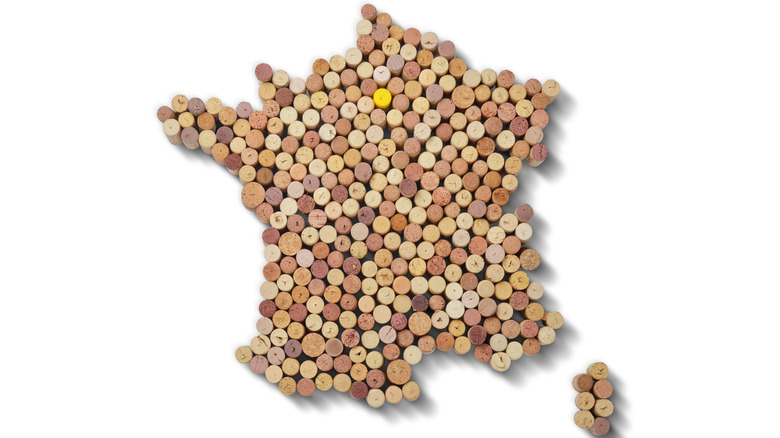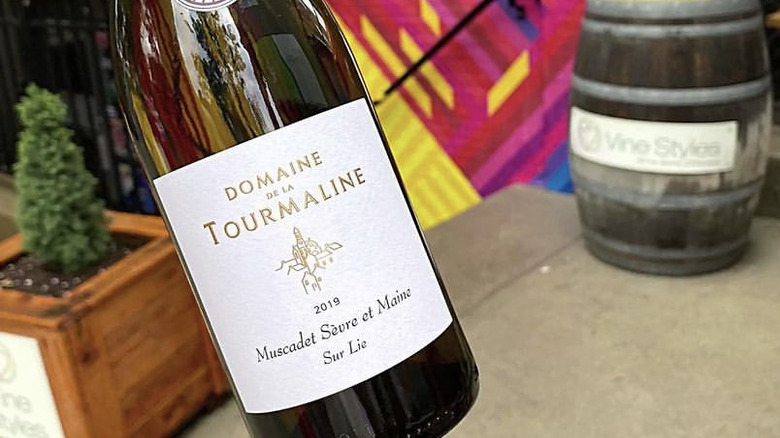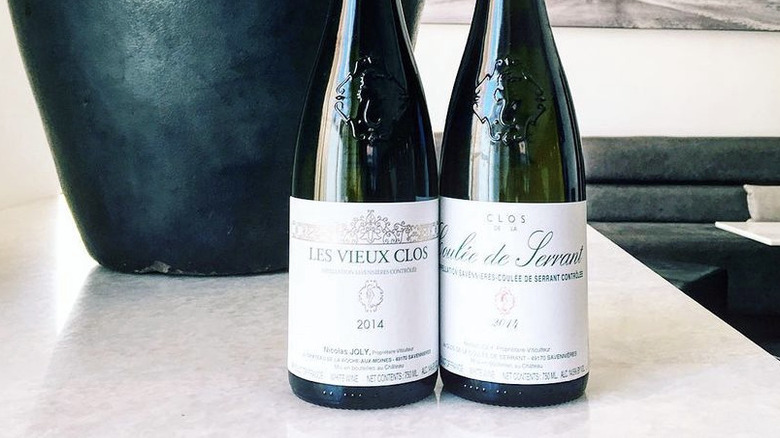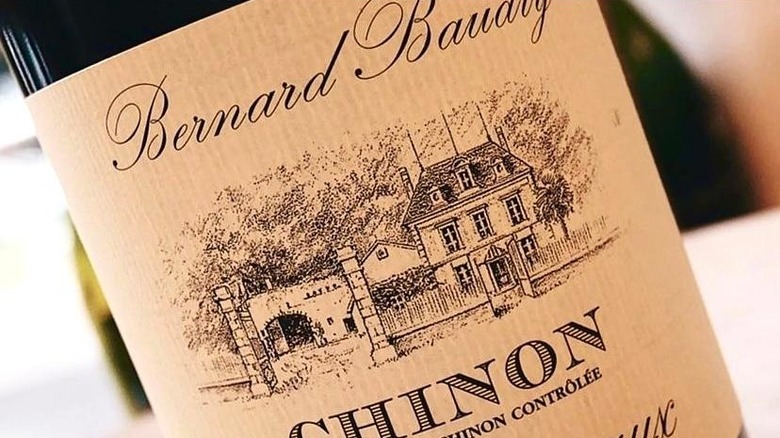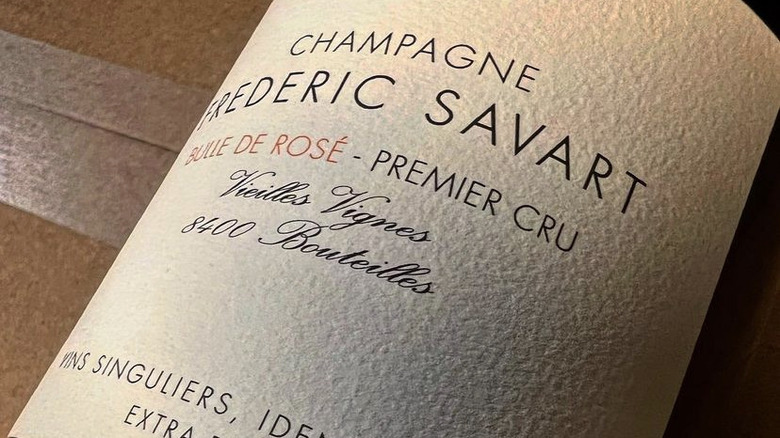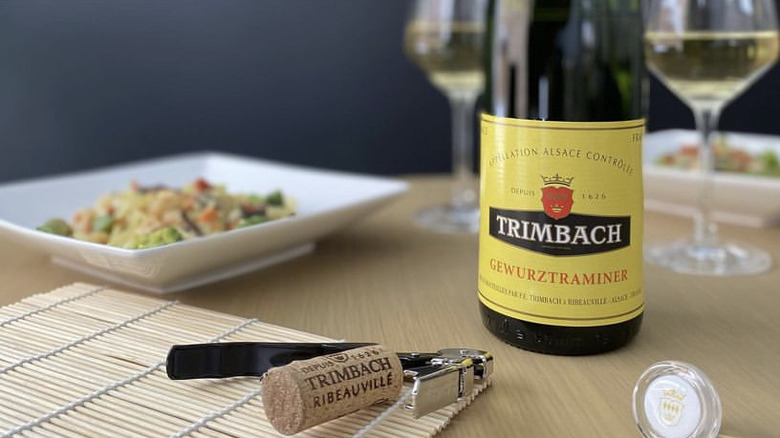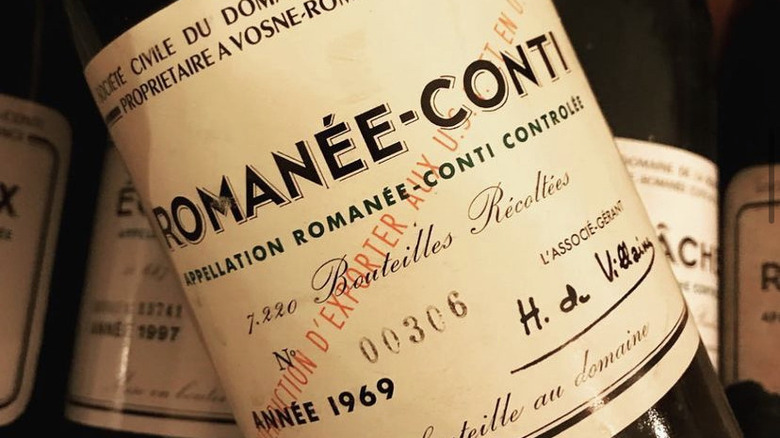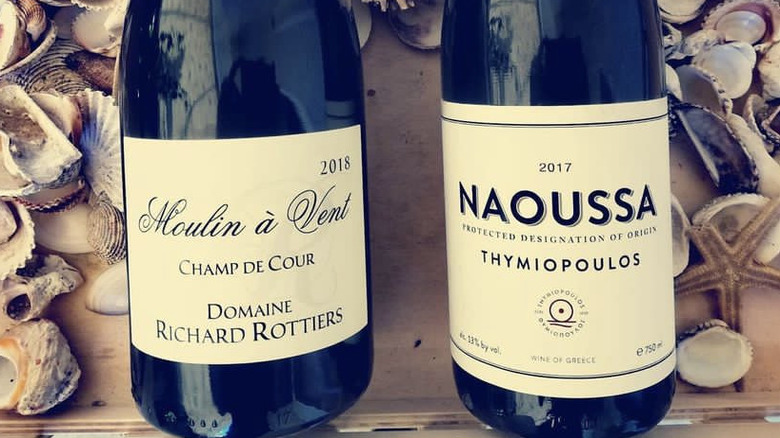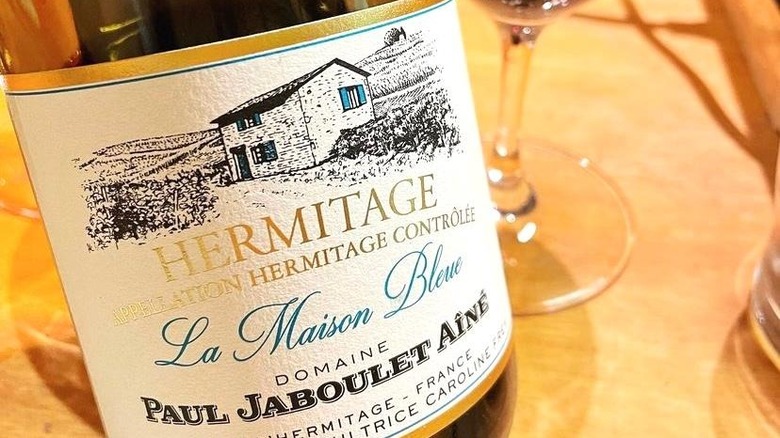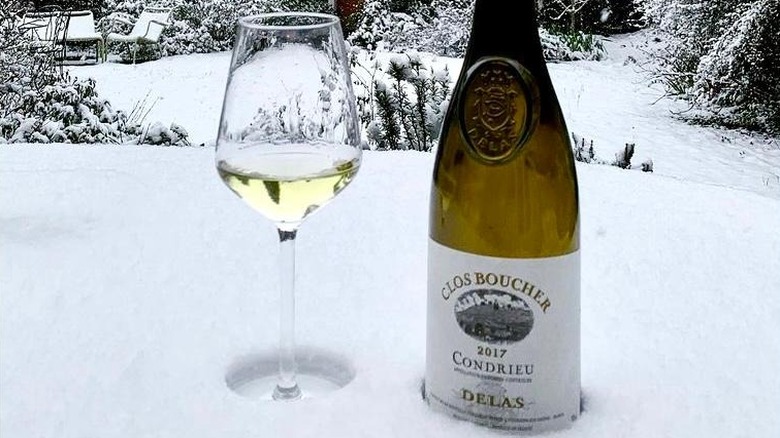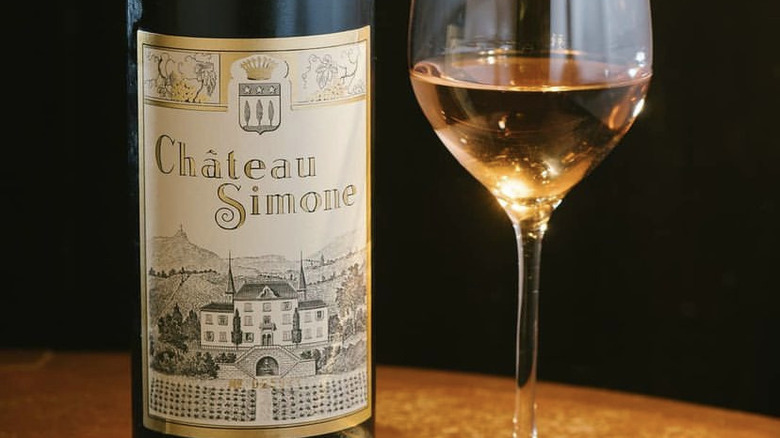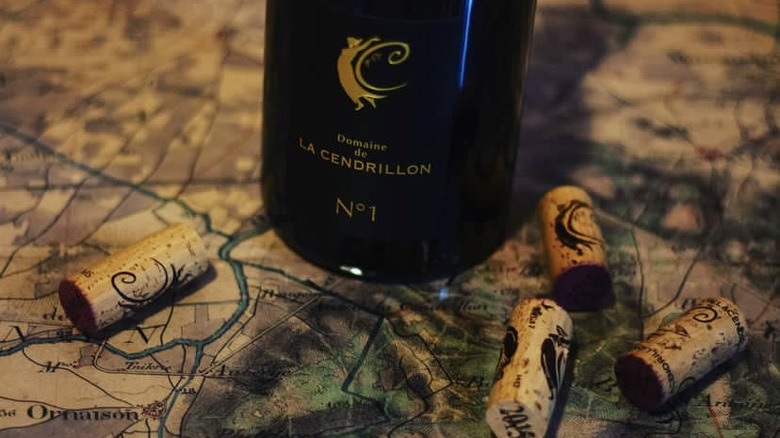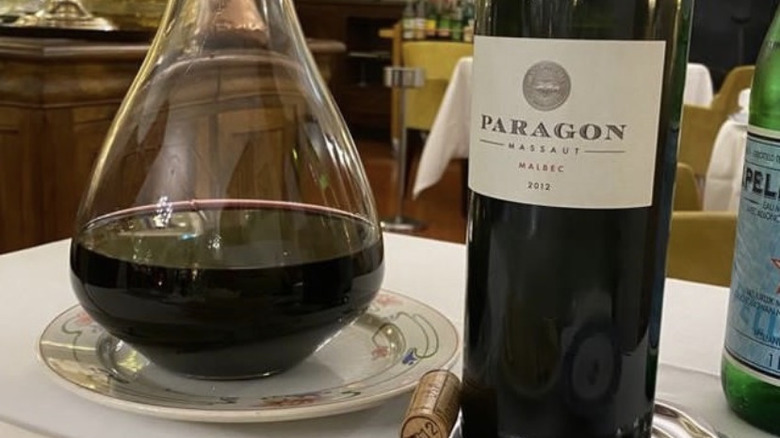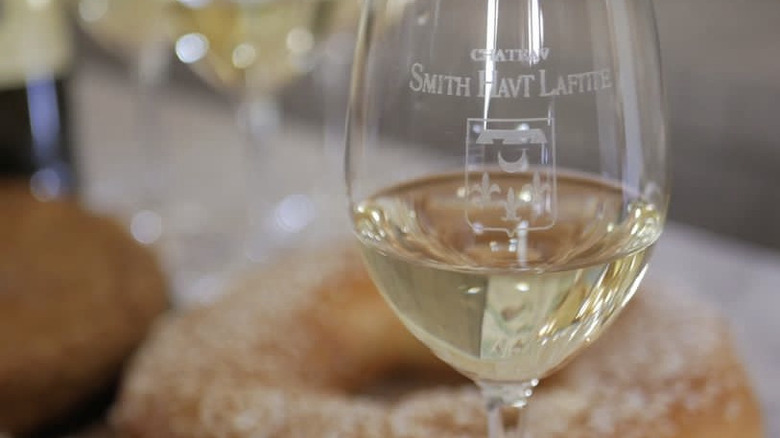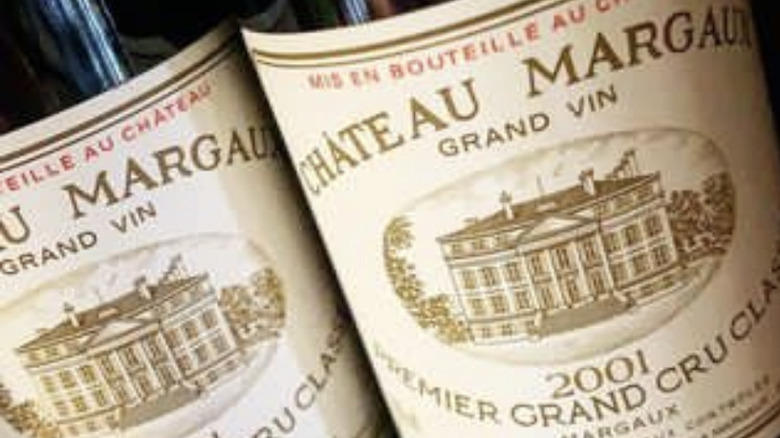Explore France With These 15 Wines
France is known for some of the most celebrated wines in the world. This year, French wines swept the Best in Show category at the Decanter World Wine Awards 2022, the most prestigious wine award competition, per Wine Industry Advisor.
"DK Wines of the World" reveals that Phonecian Greek migrants planted wine grapes along France's Mediterranean coast around 600 B.C. Roman legions took wine grape vines west to Aquitaine (now Bordeaux), and north via the Rhône. After the fall of the Roman Empire, Cistercian monks in Burgundy, Champagne, and the Loire Valley became stewards of the land and the vine for centuries. The Brits developed a voracious taste for French Bordeaux when Duchess Eleanor de Aquitaine, formerly the wife of France's King Louis VII, divorced and married Henry Plantagenet — future King Henry II of England. She took Acquitaine as her dowry, ensuring a strong British-French political and trade alliance that remained in place until 1453. Due to the cold climate, the Brits could not make quality wine in England until now, per the New York Times.
In fact, climate change's impact on wine is global. Wine producers report that climate change is wreaking havoc on viticulture in the most prominent wine regions across the globe, France included, per the New York Times. French wines we have come to know over the last few centuries are in danger of becoming obsolete. We've compiled a list of classic French wines worth trying to explore the country's vast — and ever-changing — wine tradition.
Domaine de la Tourmaline Muscadet Sèvre et Maine -- Loire Valley
The westernmost reaches of the Loire River valley flow through Nantes, an ancient town in Brittany near the beginning of the estuary into the Atlantic Ocean. Nantes is home to a quaint wine region known as Muscadet Sèvre et Maine. The Muscadet Sèvre et Maine AOC/AOP region has unique geographical signatures and an oceanic climate, perfect for a grape called melon de Bourgogne. A white varietal is used to produce bright, tangy, and often slightly spritzy wines that complement the abundance of seafood, bivalves, and Breton oysters, common to the regional cuisine.
Domaine Gadais Père et Fils has been producing refreshing Muscadet wines for five generations. Its signature wine, Domaine de la Tourmaline, is sourced from a specific vineyard parcel on the estate known for its exalted fruit. The wines are produced in the classic sur lie style, which means the wine is aged on its yeast and sediment, layering its crunchy acidity with a silky, and flavorful richness that makes Muscadet Sur Lie an incredible wine to know.
Nicolas Joly Savennières Les Vieux Clos – Loire Valley
Just east of Nantes is Anjou, formally called the Duchy of Anjou, an ancient kingdom that predates a unified France. The rich agricultural region is best known for sweet wines, but produces a small quantity of dry red and rosé wines from cabernet franc and dry white wines from a grape called chenin blanc. Chenin blanc is a rare grape that can be crafted into dry or sweet wines, some still and some sparkling, because of its prominent acidity and abundant aromatics, per Wine Folly. With aroma and flavor notes of peach, yellow apple, white flowers, zesty citrus, and warm saffron or butterscotch notes, chenin blanc is delicious.
In 1130, Cisterian monks planted the original 7-acre vineyard now owned by the legendary Nicolas Joly. Coulée de Serrant is a tiny biodynamic vineyard that was prized by kings and their courts. The 2022 vintage marks the 892nd year of producing incredible wines, per Coulée de Serrant et Nicolas Joly. Les Vieux Clos is an adjacent, walled-off parcel of old chenin blanc vines produced in a classic, barrel-aged style for rich aromas and flavors. Savennières Les Vieux Clos is considered a benchmark for exceptional quality in chenin blanc from the Savennières subregion.
Bernard Baudry Le Clos Guillot Chinon -- Loire Valley
East of Anjou lies another ancient kingdom called Touraine. The regions of Anjou and Touraine are home to some of the most majestic castles in all of France. Picturesque landscapes and bucolic countryside are dotted with medieval castles renovated in Renaissance glory. Before the French Revolution, the Loire Valley in Touraine was the summer retreat for the French aristocracy because of its proximity to nearby Paris (via Terroir Travels). The region is still called the garden of France for its abundant food and wine, per Lonely Planet. The wine subregions produce world-class still white, red, and rosé wines, alongside some sparkling and dessert wines, from chenin blanc, cabernet franc, sauvignon blanc, and small plantings of gamay and côt (malbec) grapes.
Chinon is best known for its lush red wines crafted from cabernet franc, a parent grape to its more famous descent, cabernet sauvignon. Located on rolling vineyards, each with unique terroir and soil substrates, Bernard Baudry produces a range of terroir-driven mono-varietal wines from chenin blanc and cabernet franc. Known for minimally-invasive viticulture and vinification, Bernard Baudry wines are as natural as wine can be. Look for the robust Le Clos Guillot Chinon, made from 100% cabernet franc. The wine has robust dark fruit, blackberry, and plum notes with a hint of baking spice, clove, pencil shavings, and vanilla on its lingering finish.
Frédéric Savart Bulle de Rosé Champagne – Champagne
The Champagne region in The Marne, just east of Paris, is known for its sublime sparkling wines. It is also one of the most storied battlefields in the world, according to the book "Champagne," which reports the region has been host to major wars since the time of Attila the Hun up through both World Wars. It is ironic, then, that the region produces wines meant for celebrations of life's blissful occasions.
Champagne has an almost exclusively limestone soil substrate and bedrock, perfect for grapes, per Comité Champagne. Roman legions mined the limestone for buildings and roads, leaving miles of perfectly temperate limestone caves, called crayeres, first used by Madame Ruinart in 1820 (via History Guru) as a means for storing her champagne for aging. Soon, champagne crayeres wormed beneath the very foundation of the region and its cities, Reims and Épernay.
Frédéric Savart is something of a daring modernist in Champagne. Known as a micro-grower, Savart's focus is on purity and identity. Rather than adhering to the regional tradition of house style, Savart lets the land and season drive his wines. As a result, his wines are austere, lithe, and exceptionally terroir-driven — a rarity in the region. Savart Bulle de Rosé is a floral wine with delicate berries and Amaretti biscuit notes. Lift a glass of champagne and celebrate its most famous glorious elixir.
Trimbach Gerwürztraminer – Alsace
In the northeast corner of France, bordering Germany, is a multi-national region called Alsace. Throughout its lengthy wine-producing history, the region has volleyed between Germany and France, until 1945, when it became officially French, per "Wines of the World." Alsace shares its signature grape varietals — riesling, gerwürztraminer, pinot blanc, and pinot noir — as well as much of its cuisine with its Germanic brothers and sisters.
Maison F.E. Trimbach has been producing wine in the Ribeauvillé region since 1626, and has adapted to the constant change in identity and culture by steadfastly producing elegant and lively wines derivative of the regional terroir. Originally from Switzerland, the Trimbach family, now in its 13th generation, crafts characteristically Alsatian wines. The range includes still wines along with late harvest and dessert wines produced from riesling, pinot blanc, and gerwürztraminer. These grapes exude floral notes, but Trimbach gerwürztraminer is particularly seductive with its clove and spice tones that surprise the palate.
Domaine Laroche Grand Cru La réserve de l'Obédience – Chablis, Burgundy
Britannica reveals that Burgundy is a lengthy wine region, once belonging to the Kingdom of Burgundy, in east-central France. It flanks the Saône river, which flows from northeastern France into the Rhône river to the south. The region is known for its agriculture and noted for its cuisine — in fact, the city of Lyon is considered one of the world's great food cities, according to Travel & Leisure.
The northernmost sector of Burgundy is called Chablis. In fact, Chablis is closer to Champagne than to the rest of Burgundy, per Wine Folly. Its location and high latitude give Chablis a cool climate and limestone substrate soil that grapes love, per Vins de Bourgogne. Chablis focuses on one grape: chardonnay, which is exalted from the region. Chablis chardonnay is generally unoaked and tends to be ethereal with racy acidity, and notes of tart apples, passionfruit, lime zest, and its signature flinty minerality.
One esteemed producer is Domaine Laroche, known for its austere-yet-opulent expression of chardonnay. Domaine Laroche is committed to minimally-invasive viticulture and vinification techniques resulting in gorgeous wines with clean and fresh notes of crisp fruit, chalky mineral, and fragrant white flowers. Its La Réserve de l'Obédience is a blend from several grand cru vineyards resulting in the best cuvée from the house.
Domaine de la Romanée-Conti Romanée-Conti -- Côte de Nuits, Burgundy
The primary region of Burgundy is known for its pinot noir and chardonnay, and small amounts of aligoté, pinot blanc, and gamay, reports Britannica. The best wines come from the Côte d'Or, or golden coast, which is divided into two subregions: the northern Côte de Nuits and the southern Côte de Beaune. Each subregion is parceled into tiny communes, most producing their own label of wines. The Côte de Nuits is where the most exalted red wines in the world are produced in communes called Vosne-Romanée, Échézeaux, Nuits-St-George, and Gevrey-Chambertin, per Jancis Robinson.
The Abbey of Saint Vivant in Vosne (Vosne-Romanée) acquired four-and-a-half acres of prime vineyards in 1232. Over the centuries the property swelled to 63 acres, or one-tenth of a square mile. Eight of the best grand cru vineyards in the world are found here: Romanée-Conti, Richebourg, Montrachet, La Tâche, Grands Échezeaux, Corton, Romanée-St-Vivant, and Échezeaux, per Domaine de la Romanée-Conti.
A cult classic, Domaine de la Romanée-Conti commands exorbitant prices for its range of small-production pinot noir wines including namesake Romanée-Conti, which can go for thousands of dollars. The 2004 vintage is valued at nearly $25,000, according to Wine Searcher. The wines are smooth and velvety with notes of ripe raspberry, black cherry, cypress, mushroom, smoke, and a misty forest in autumn.
Domaine Richard Rottiers (Moulin-à-Vent) Beaujolais – Beaujolais
The southern tip of Burgundy is home to a subregion called Beaujolais, which has a unique terroir and produces wines from gamay grapes. According to the official Beaujolais website, Beaujolais is comprised of 72 communes devoted to the best expression of the thin-skinned grape. Wine Enthusiast indicates that Cru Beaujolais gamay produces light and fruity wines with notes of violets, pomegranate, blackberry, flowers, and smoky or flinty earth. Depending on its vinification style, Beaujolais Nouveau can exhibit banana and bubble gum notes, per Wine Folly. When Beaujolais is good, it is a delicious food wine. Look for Cru Beaujolais, not Nouveau, that juicy drink that comes out each year just before Thanksgiving.
According to Domaine Richard Rottiers, the Moulin-à-Vent commune in Beaujolais was first planted with grapevines by Roman legions, owing its name to a 15th-century windmill rising from a hill with a view of Romanèche-Thorins. It is here that Domaine Richard Rottiers crafts its lush and dense wines. Look for Windmill, a wine produced from grapes sourced from nine vineyards.
Paul Jaboulet Aîné Hermitage La Chapelle – Northern Rhône
Once upon a time, the Rhône was home to Greeks, Romans, Popes, and marauders with a taste for exceptional wines. Rhône wines were always prized and traded across Europe. Food & Wine indicates that the Northern Rhône sets the standard for syrah wines. The grape is exalted here and the wines are lush, fruit-driven, and robust with blackberry, currant, and black cherry fruit, as well as notes of spicy pepper and smoky bacon, via Wine Folly. Yet, Rhône syrah maintains its elegance and finesse. L'Ermitage or Hermitage is considered the best syrah wine region in the Northern Rhône, and possibly the world. Some Rhône red wines exhibit an earthy, gamey, smoky note attributed to brettanomyces, which some people consider a fault. The pungent aroma is a sensory characteristic that can be a blessing or a curse (via Wine Folly).
Paul Jaboulet Aîné is a legendary producer in the Rhône, crafting wines in several subregions along the river. None are more famous than his wines from Hermitage La Chapelle, named for an ancient chapel that overlooks the valley, per Wine Searcher. Maison Paul Jaboulet Aîné acquired the vineyards near the chapel in 1919. The unique terroir and position high on the river valley slope drive the rich and intense character of the wines. Jaboulet Hermitage is crafted from old vines, which produce intensely flavored yet fewer grapes than young vines.
Delas Frères Condrieu – Northern Rhône
The Rhône river valley stretches about 150 miles from Lyon in Burgundy to the Mediterranean Sea in the south. Its terroir and climate vary from north to south, leading to drastically different wine styles. The wines from the north are restrained with prominent acidity, elegant aromatics, and moderate flavors, while the robust wines of the south can be inky and drenched with spice and ripe fruit flavors, according to Planet Wine.
Classically, the region is dominated by the syrah and viognier grapes in the north with grenache, syrah, mourvèdre (per Planet Wine), and cinsault, carignan, roussanne, marsanne, clairette, and grenache blanc as prominent in the southern regions of the Rhône, although a broad variety of grapes are grown in the region, per Vins-Rhone.
Viognier is slowly gaining its footing around the world, according to Forbes. In France, viognier from the popular Condrieu region is an exquisite expression of the grape (via Planet Wine), with floral notes of lilac and spice. Viognier also has peachy notes intertwined with honeysuckle, pale pink roses, and sweet citruses like tangerine or Meyer lemon and fresh tobacco spice on the finish (per Forbes), and what is not to love? Delas Frères produces a gorgeous Condrieu with viognier grapes sourced from multiple vineyards along the river valley.
Château Simone rosé – Palette
TV travel host Rick Steves reveals that the sunny slopes of Provence, in the southeasternmost corner of France, are known for lavender, ancient villages, Haussmann cities, fine art, bucolic landscapes, and rosé wine. Some of the most storied cities in France, from Avignon and Marseilles to Aix, Cannes, and Nice make up the French Riviera.
Palate Clubs reports that the region is studded with vineyards, some planted by Greek settlers in 600 B.C. Red grapes like mourvèdre, cinsault, grenache, and syrah flourish in the region, alongside obscure grapes like carignan and tiburon. Aromatic white grapes such as grenache blanc, clairette, roussanne, sémillon, and small plantings of chardonnay, and sauvignon blanc, can be found there as well. The region is dominated by its red, white, and rosé blends.
Regions like Côtes de Provence, Bandol, Cassis, Coteaux D'Aix-en-Provence, and Les Baux-de-Provence are famed for their wines, while little 100-acre gems like Palette are unknown, per Wine Folly. Provençal wine estate Château Simone has been producing world-class wines on its castle-adjacent vineyards since 1820, but vines have been grown in the region for more than 1,000 years. Its vineyards, scattered throughout wooded and wild spaces, are strictly organic. Château Simone expertly crafts red and white wines that express its terroir but it is the old-vine rosé — with its notes of strawberry, peach, lemon zest, and chalky mineral — that is the crowd pleaser.
Domaine La Cendrillon No. 1 – Corbières, Languedoc
Greco-Roman settlers explored the southwest coastal regions of France, blending their culture with that of the native inhabitants, evidenced by the rich archeological and historical villages, buildings, ruins, and monuments left by these people, per WineTourism. Known as Occitania, the region maintained its freedom until the Middle Ages and still maintains elements of its ancient Provençal language, per Culture Trip. These explorers planted vineyards from the Pyrenees mountains bordering Spain in the west, throughout the region. This wine region, called Languedoc-Roussillon, is massive. Within Languedoc-Roussillon, the Corbières AOC subregion stretches from the base of the Pyrenees mountains east to Narbonne. With its ruggedness and unique terroir, the region produces incredible, robust, flavorful wines from grapes like mourvèdre, carignan, cinsault, grenache, and syrah grapes, per Wine Tourism. Largely undiscovered until recently, Corbières wines are gaining traction.
One such wine producer is called La Cendrillon, or Cinderella, named for an ancient château and estate in Ornaisons, a village just outside of Narbonne. La Cendrillon is an organic and biodynamic property known for its inky and lush red wines. La Cendrillion No. 1 is the first wine produced by the heir to the estate. Crafted from old vines, the wine is rich and exudes spicy blackberry bramble, black plum, mocha, and smoky grilled meat notes.
Château Lagrézette Paragon – Cahors
Malbec lovers will adore wines from Cahors. It is the original home for the grape known as côt, and the wines from this region are grittier, richer, denser, and heavily perfumed, per World's Best Wines. Cahors wines were adored by Roman aristocrats, exported across Europe from Russia to England, and even became the official wine of Pope John XXII in 1325, per Clos la Coutale (a Cahors producer). Eventually, war, economics, and phylloxera decimated the region. In 1947, wine producers took notice and revitalized much of the region, but frost killed off the new vines in 1956. Undeterred, new plantings of côt, tannat, and merlot began to thrive, and now, Cahors is producing world-class wines once again.
Château Lagrezétte was built in 1503. The vineyards, dating to the same era, honor regional traditions by focusing on côt, or malbec, as it is known across the world. Situated on chalky limestone and clay soils, grapes thrive at Chateau Lagrezette and across Cahors. Paragon is a perfect example of great malbec. World-renowned winemaker-consultant Michel Rolland consults on the world's best wines, and Paragon is his pet project. Highly-rated, and award-winning, Paragon is an exalted expression of malbec with its inky fruit, blackberry bramble, rustic edges, and layers of tobacco and cocoa.
Château Smith Lafite Graves blanc – Graves, Bordeaux
According to Forbes, Bordeaux is the wine capital of the world and among the most influential wine regions in the world. "DK Wines of the World" explains that it is an ancient and busy port city in the heart of Aquitaine with a storied history that dates back to the Roman Empire. Vines were planted on the banks of the Garonne river and Gironde estuary by Roman settlers and became an important trading commodity under Pax Romana. Furthering Bordeaux's presence on the world stage, the marriage of Eleanor de Aquitaine to the future King Henry II of England took its wine trading to the next level, per Vins de Bordeaux. Napoleon ordered a ranking of the wine estates in Bordeaux in 1855 for the World's Fair (via Les Conseil des Grands Crus Classés). The five-tiered 1855 Classification denotes quality and price from Cru Classé (top) producers, according to Vins de Bordeaux.
Graves is a subregion known for its steely, sauvignon blanc white wines with notes of ocean grass, zesty citrus, gooseberry, saline, and smoke. Cru Classé Château Smith Lafite produces some of the region's best Graves blanc (sauvignon blanc). It boasts its own Caudalíe Vinothérapy wine spa where you can soak in and sip on some of the best wine in France, a massive luxury brand founded by a daughter of the estate, Mathilde Thomas-Cathiard, and her husband, Bertrand.
Château Margaux Premier Cru red – Margaux, Bordeaux
Throughout this history, Bordeaux has held true to its formula: Red wines produced from cabernet sauvignon, merlot, cabernet franc, petit verdot, and a splash of malbec, and white wines from sauvignon blanc and sémillion. Times are quickly changing in the 21st century. Climate change is forcing the region to consider hybrid grapes along with Spanish varietals and Portuguese varietals, per the New York Times. While this is changing the Bordelais formula, they are allowing different varietals hoping to combat searing heatwaves and pervasive droughts.
The preeminent Cru Classé producers have been slow to adapt their winning recipe for exceptional wines, ignoring climate change until recently, according to Wine Enthusiast. Winemakers continue to produce the signature Bordeaux blend of potently flavored cabernet sauvignon or merlot grapes, but they are experimenting with new disease- and late frost-resistant varietals, per The New York Times. The left (south) bank of the Gironde estuary is dominated by cabernet sauvignon and home to the most legendary wine estates in the world. Château Margaux is one of the original five first-growth Grands Cru Classé (top of the top) producers in the Médoc region. In comparison to the others, Grand Vins Margaux is known for its soft, elegant, even feminine style, with fragrant aromatics and restrained black currant, black cherry, cypress, graphite, anise, and tobacco notes.
